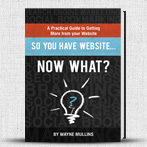A Practical Guide to Putting Your Business on Autopilot – Market Need
Posted by Wayne in Business Growth
MN – Stands for Market Need
Both the Broken Business Formula and The Business Freedom Formula contain Market Need as a core component. So, what’s the difference?
The Broken Business Formula teaches that you should identify what the market needs, first. To do this, you look at what is currently being provided in one area, and then look for other areas–whether geographically or demographically–where you might provide the same product or service.
As an example, you notice that coffee shops do really well in your town, but there isn’t a coffee shop in the newly developed area of town, so you identify this as a market need. On the surface this sounds good, but the problem lies under the surface. With this definition of Market Need you are forced to make too many assumptions.
Using the same coffee shop example from above, what if you decided to open a coffee shop in this newly developed area of town based on this perceived market need, only to discover that most of the residents moving to this new area of town were retired people? In your town, retired people are accustomed to making their own coffee at home, and they don’t get excited about paying $5 for a specialty coffee beverage.
In this example, you will have made your decision on false (or perceived) market need, and not on the true market need.
Under The Business Freedom Formula, market need means that you identify a market based on a demonstrated actual need.
=============================
Market Need Exercise
Learning to identify a potential Market Need is a skill. This is great news for you, because skills can be developed and improved with practice. With a little work on your part you can develop the skill of discovering potential Market Need.
What I’ve discovered over the years is that Market Needs are in front of people each and every day, but most let them slip by without seeing or hearing the need. Here’s an exercise to help you both see and hear Market Needs throughout your day.
Step 1:
Write down 10 specific things you do when you first wake up in the morning.
STEP 2:
Now that you’ve compiled your list, it’s time to begin training your brain to look for what works well, what doesn’t work, and what could be further improved.
Go back through your list and ask yourself the following question: Wouldn’t it be great if….?
As an example, let’s say that the first thing you do when you wake up is reach over and hit the snooze button on your alarm. You’ve developed this habit because sometimes you’ve been known to doze back off to dream land. Other times, though, you hit the snooze button then immediately get up and head for the shower without remembering to actually turn off your alarm. Which technically isn’t a problem for you; it’s your partner who’s still trying to catch a few more ZZZ’s that your sounding alarm REALLY bothers.
If this were true, then in this example you may say: Wouldn’t it be great if my alarm clock had some way of knowing that I was actually up and out of the bed? This would prevent me from forgetting to shut it off and then having to deal with my angry partner when I get out of the shower.
When you start asking yourself this question, don’t critique yourself. Instead, just make note of your answers regardless how out there, crazy, or unrealistic they may seem.
STEP 3:
For this final step it’s now time identify a couple of possible ways you could achieve your “wouldn’t it be great” statement.
Go back to our statement “wouldn’t it be great if my alarm knew to shut off when I got out of bed?” and list out a couple of ways you think this could happen.
Idea #1: My alarm could automatically turn itself off if it had a motion sensor built in that detected when someone was moving around the room.
Idea #2: My alarm could automatically turn itself off if it had a built in microphone that detected the sound of the bathroom door closing.
Idea #3: My alarm could automatically turn itself off if it had a sensor that connected to the bed and detected movement when I got out of the bed.
Again, don’t worry about how realistic or achievable the ideas may be; instead, just make a list.
Don’t make the mistake of believing that this exercise has nothing to do with learning how to identify Market Need. By repeating this exercise several times, using a different scenario each time, you are forcing your brain to look past what’s obvious and explore what could be possible.
Here are a few different scenarios to try using this exercise:
10 things that happen when you walk out your door for the office.
10 things that occur when you get in your car.
10 things that happen when you sit down at a restaurant.
10 things that happen when you eat pizza.
Recommended Resources:
Here are a few books that will help you think outside the box and help train your brain to identify Market Need.
How to Make Millions with Your Ideas
CONCLUSION:
If you’re going to put your business on autopilot you have to be sure the market actually wants your product or service. Identifying market need is easy, but it does require time.
In the next post we’ll cover how to find and utilize Unmarketed Talent.
Want to learn more about the Business Freedom Formula? You can get exclusive videos and our step-by-step guide over at FreelancersFreedomFormula.com.
- Likes, Shares, & Comments WON'T Put Money In Your Bank Account.
- In Our Free Course: Crush It On Facebook In 30-Days Or Less
- You'll Discover: A Simple Facebook Strategy We Used To Take a Client From Losing $10k Each Month To Making Thousands...In Only 86 Days.
- The 3-Step Formula We Used To Increase Another Client's Sales By Over $9,000 per Month (and they're spending less than $400 per month on Facebook Ads)



